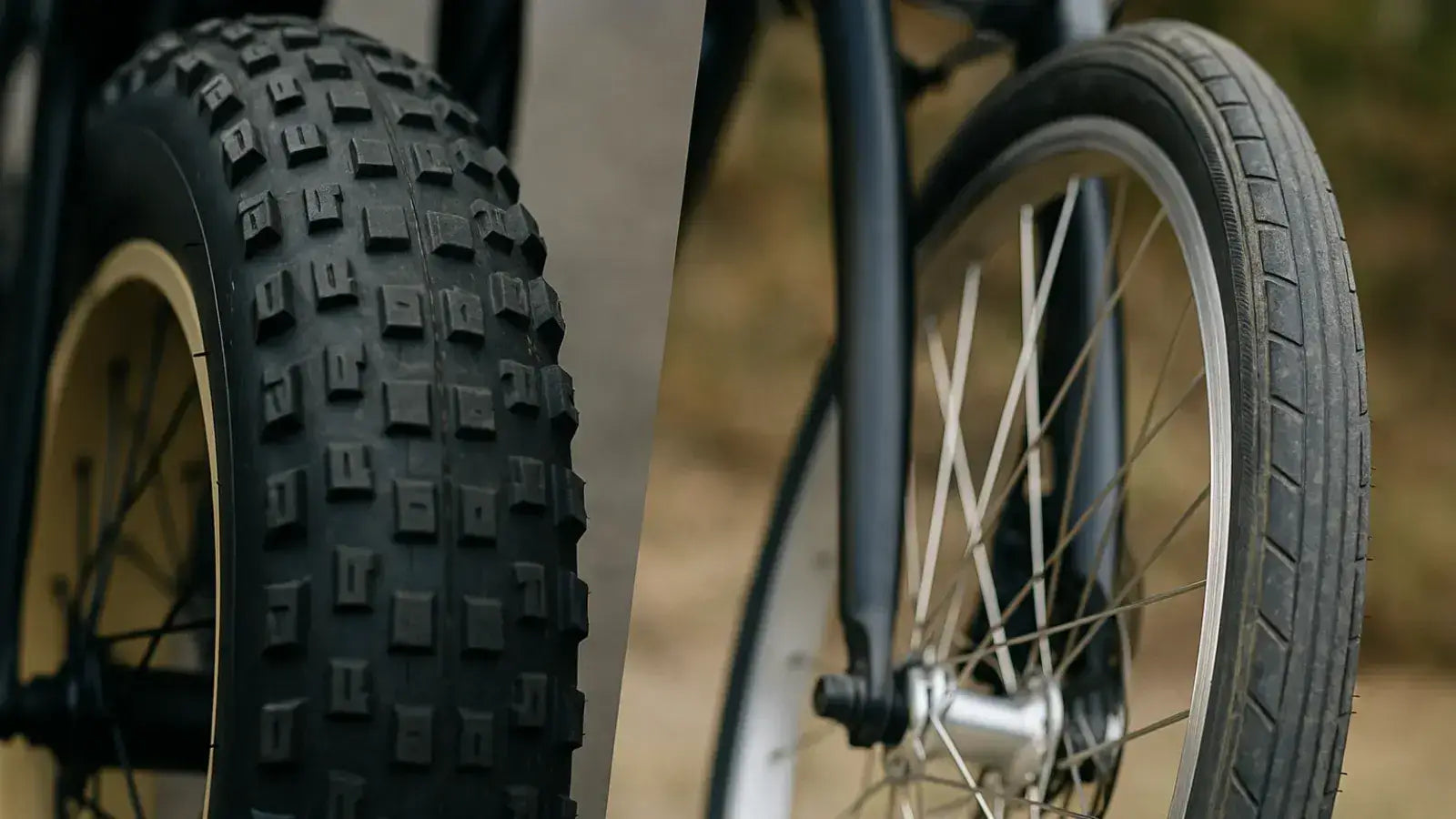
26x4 Fat Tire vs 26x2.35: Which Bike Tire Wins?
Understanding Tire Sizing
Picking between a 26x4 fat tire and a standard 26x2.35 mountain bike tire can be tough. Both work great, but they're made for completely different riding styles and places. Think about it this way: the 26x4 fat tire is the best choice for grip and comfort, built to handle the hardest surfaces. The 26x2.35 tire is the quick, smooth choice for mixed trails and riders who want speed.
Our goal is to give you a detailed comparison to help you pick the right tire for your needs, bike, and riding style.
Before we talk about how they perform, let's explain the numbers. Knowing what "26x4" and "26x2.35" really mean helps you understand this guide and all future tire specs. It's easier than it looks.
- 26 inches: This number shows the size of the wheel that the tire fits. For this comparison, it stays the same. Both tires work on a 26-inch rim, so we're comparing the same basic size.
- 4 inches vs. 2.35 inches: This is how wide the tire is, and it's the main thing that makes them different. A 4-inch tire is much wider than a 2.35-inch tire, which changes how the bike rides and what it can do.
- ETRTO Sizing: For the most exact measurements, pros use the ETRTO standard. For example, a 26x4.0 tire might be listed as 98-559. The "98" is the exact width in millimeters, and "559" is the exact rim size in millimeters. This is considered an accurate tire sizing standard and helps make sure parts fit together.
Direct Performance Comparison
The biggest differences between these two tires show up when we compare how they perform. The choice isn't about which is "better" overall, but which works better for what you want to do.
| Performance Metric | 26x4 Fat Tire | 26x2.35 Tire |
|---|---|---|
| Traction & Grip | Exceptional, especially on loose surfaces | Very Good, especially on hardpack |
| Comfort & Suspension | Superior, acts as natural suspension | Good, relies more on bike suspension |
| Speed & Rolling Resistance | Slower, high resistance | Faster, lower resistance |
| Weight | Heavy | Lighter |
| Agility & Handling | Slower, stable | Nimble, responsive |
| Ideal Terrain | Sand, Snow, Mud, Rough Trails | Hardpack, Gravel, Pavement, General Trails |
Traction and Grip
The huge width of a 26x4 fat tire makes a much bigger contact patch—the part of the tire touching the ground. This is why it grips so well. On soft, loose surfaces like sand, snow, or deep mud, the tire spreads the bike's weight over a wider area, letting it "float" on top instead of sinking in and getting stuck.
This makes it perfect for riding in all seasons. A 26x2.35 tire has a smaller contact patch, which works great on firm ground like hard-packed dirt or rock, but it can have trouble in deep, loose conditions. Grip also depends on a tire's tread pattern and rubber compound, but width is the main factor here.
Comfort and Cushioning
This is where the 26x4 fat tire really wins. Its huge air volume lets it run at very low pressures. Fat tires usually run between 8-20 PSI. This low pressure turns the tire into a kind of suspension, soaking up bumps, roots, and rocks really well.
The ride feels incredibly smooth and easy. A 26x2.35 tire needs higher pressure—usually between 25-45 PSI—to prevent flats and keep its shape. While it gives some cushioning, it's much less forgiving and needs the bike's suspension system to smooth out the trail.
Speed and Efficiency
Nothing comes free in cycling. The same things that give the 26x4 tire its amazing grip and comfort also make it slower and less efficient. The extra weight and large contact patch create much higher rolling resistance, especially on smooth surfaces like pavement.
It takes more energy to get a fat tire up to speed and keep it there. The 26x2.35 tire is much lighter and has a smaller, more focused contact patch, creating much lower rolling resistance. It speeds up quicker, keeps speed more easily, and feels much faster and more efficient on pavement, gravel, and most regular trails.

The Real-World Feel
Numbers and specs only tell part of the story. The real difference between these tires shows up when you ride them. We've spent many hours on both setups, and the experience is totally different.
Riding a 26x4 Tire
Getting on a bike with 26x4 tires makes you feel confident right away. You feel like you're riding an unstoppable machine that can go anywhere. There's a strong sense of stability; the bike feels planted and secure, especially on loose or bumpy terrain.
You find yourself going over obstacles like roots and rock gardens that you might avoid on a narrower tire, just rolling over them without thinking twice. On sand or snow, the feeling of "floating" is unique and empowering. The downside shows up on pavement, where you can hear the loud hum of the big knobs and feel how hard you have to pedal.
It's not about speed; it's about being able to go anywhere and feeling unstoppable on the trail.
Riding a 26x2.35 Tire
The 26x2.35 tire feels quick, playful, and responsive. The bike speeds up instantly and feels ready to change direction. You can whip it into corners, jump off small trail features, and keep momentum on rolling terrain with ease.
The ride experience connects you more to the trail; you feel more of the surface texture, which can be good and bad. It tells you what the trail is doing directly. This is the tire for riders who want agility, speed, and a responsive feel.
It's an all-around tire that works great in most trail conditions, a point often mentioned in rider discussions about the trade-offs when switching between tire types.
Matching Tire to Rider
So, which tire is right for you? The answer depends completely on where you ride, how you ride, and what matters most to you. Let's break it down by rider types.
- Choose the 26x4 Fat Tire if you are:
- The All-Season Explorer: You don't let weather stop you. You ride year-round and need a tire that can handle snow in winter, mud in spring, and sandy trails in summer without problems.
- The Comfort Seeker: Your top priority is a smooth, cushioned ride that gets rid of harsh bumps. This is especially true if you ride a rigid (no suspension) bike, as the tires will provide all the cushioning.
-
The Off-Road Adventurer: You often ride very rough, undeveloped, or unmaintained trails. For you, maximum traction, float, and stability are must-haves for safety and fun.
-
Choose the 26x2.35 Bike Tire if you are:
- The Classic Trail Rider: You spend most of your time on singletrack, fire roads, and mixed terrain where a balance of grip, speed, and agility makes for a fun ride.
- The Efficient Commuter: A big part of your riding is on pavement or hard-packed gravel paths. You value speed and easy pedaling over ultimate off-road ability.
- The E-Bike Rider Focused on Range: You want to get the most from your battery. The lower weight and reduced rolling resistance of a 2.35" tire are much more efficient, directly giving you more miles per charge. As experts note, understanding how fat tires impact e-bike performance is important for e-bike owners.
Practical Buying Factors
Beyond performance, a few practical things can make the decision for you. It's important to think about compatibility, cost, and maintenance before you buy.

Frame and Fork Clearance
This is the most important factor. You cannot just put a 26x4 fat tire on a standard mountain bike frame made for 2.35" tires. A 4-inch wide tire needs a specific "fat bike" frame and fork with much wider clearance to fit its massive size.
On the other hand, while you can often fit a narrower tire on a fat bike rim, it's not always ideal. Always check your frame's maximum tire clearance specs.
Cost and Availability
Generally, 26x4 fat tires and their inner tubes cost more than standard 2.35" ones. They are a specialty item, and the larger amount of material adds to the higher cost. They can also be slightly harder to find in local bike shops, though you can find them easily online.
E-Bike Battery Impact
We mentioned this earlier, but it's worth saying again. For e-bike riders, the tire choice directly affects battery range. The increased weight and rolling resistance of a 26x4 fat tire will drain your battery faster than a 26x2.35 tire.
If getting the most distance is your goal, the narrower tire is the clear winner. For any tire, optimizing your tire pressure for performance is key to getting the best efficiency and ride feel.
The Final Verdict
The choice between a 26x4 and a 26x2.35 tire is a classic case of specialization versus versatility. There is no single "best" tire; there is only the best tire for your journey.
To sum up, the 26x4 fat tire offers an unmatched experience of traction, comfort, and stability, making it the top choice for extreme conditions like snow, sand, and the roughest trails. This ability comes at the cost of speed, weight, and efficiency on smoother surfaces.
The 26x2.35 tire is the perfect all-rounder, giving a fast, agile, and efficient ride that works great for most common trails, from hard-packed singletrack to gravel roads and pavement.
In the end, the decision depends on an honest look at your riding. Be realistic about the terrain you ride most often and the experience you want. Choose the tire that best matches the adventures you have planned, and you'll be happy with every pedal stroke.
FAQ
Q: Can I put a 26x4 fat tire on my regular mountain bike?
A: No, you cannot put a 26x4 fat tire on a regular mountain bike frame. Fat tires need special "fat bike" frames and forks with much wider clearance to fit the massive 4-inch width.
Q: Which tire is better for e-bike battery life?
A: The 26x2.35 tire is much better for e-bike battery life. It's lighter and has lower rolling resistance, which means your motor uses less power and your battery lasts longer.
Q: What air pressure should I use for each tire type?
A: Fat tires (26x4) typically run at 8-20 PSI, while 26x2.35 tires need 25-45 PSI. The lower pressure in fat tires provides more comfort and traction, while higher pressure in standard tires prevents flats and maintains speed.
Q: Are fat tires good for snow and sand riding?
A: Yes, 26x4 fat tires are excellent for snow and sand. Their wide surface area lets them "float" on top of soft surfaces instead of sinking in, giving you much better traction and control.
Q: Which tire is faster on pavement and smooth trails?
A: The 26x2.35 tire is much faster on pavement and smooth trails. It has lower rolling resistance, weighs less, and requires less effort to pedal, making it the clear choice for speed and efficiency on hard surfaces.




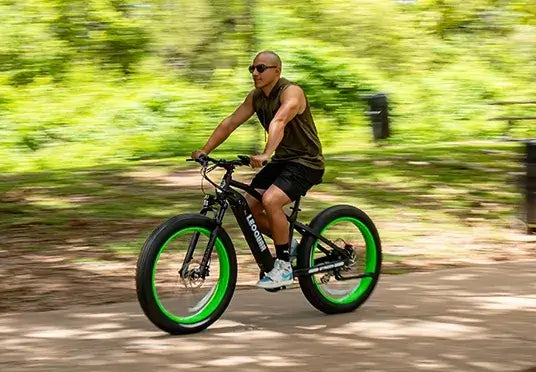



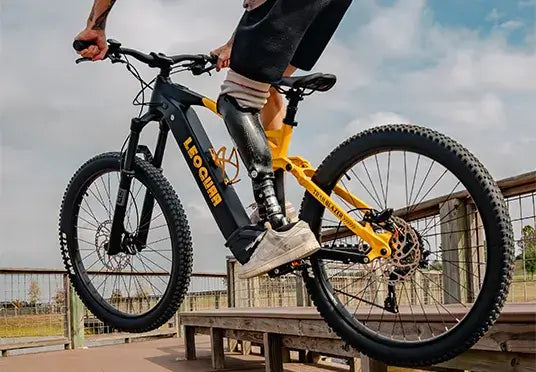
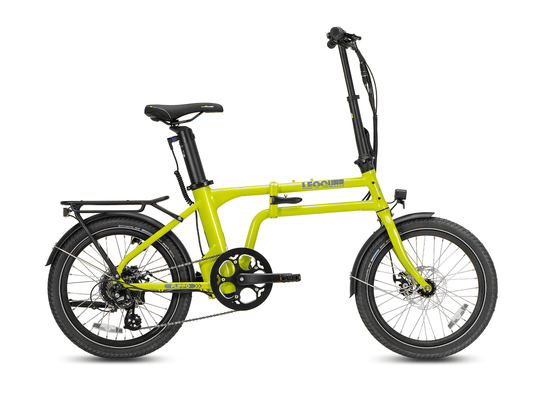
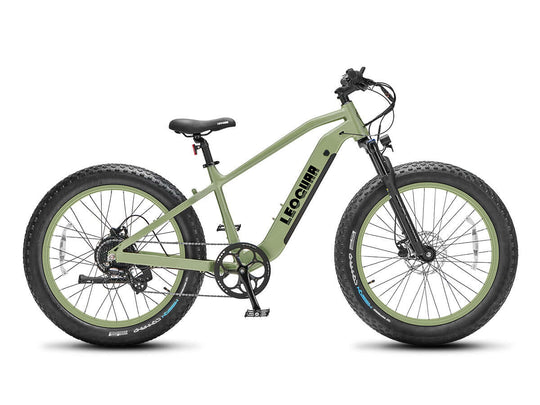
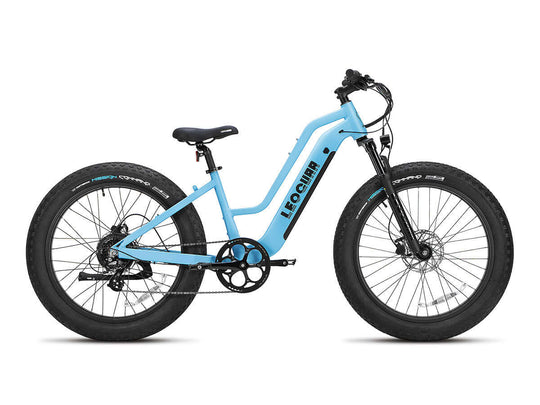
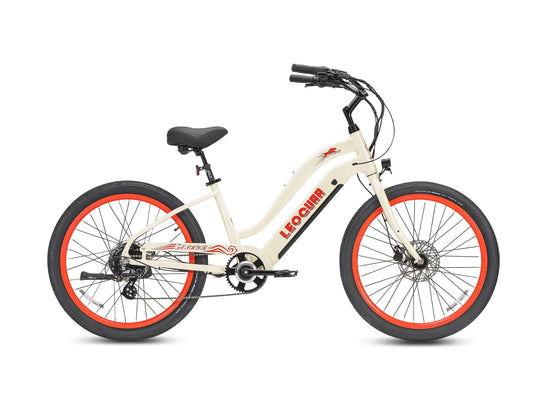
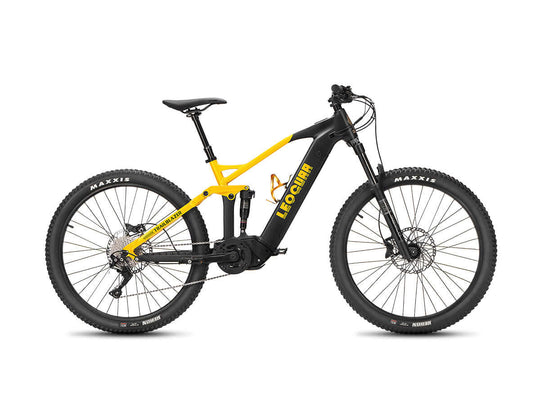
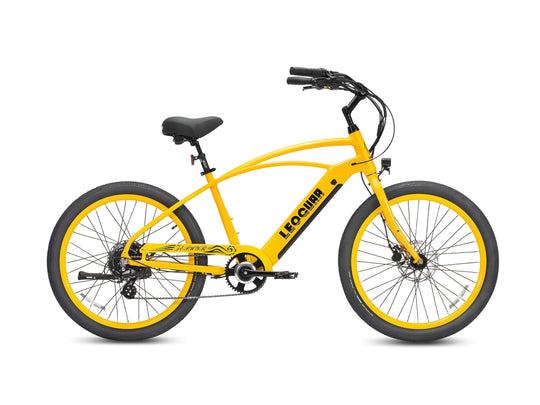
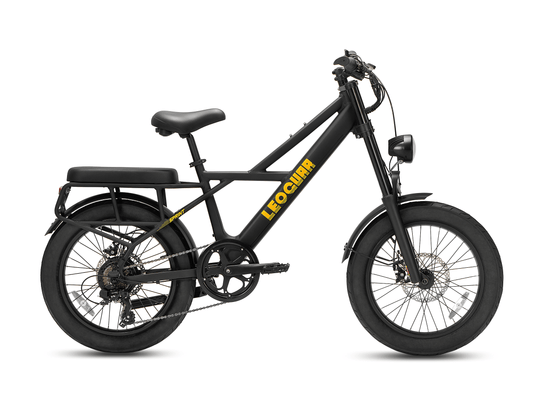
















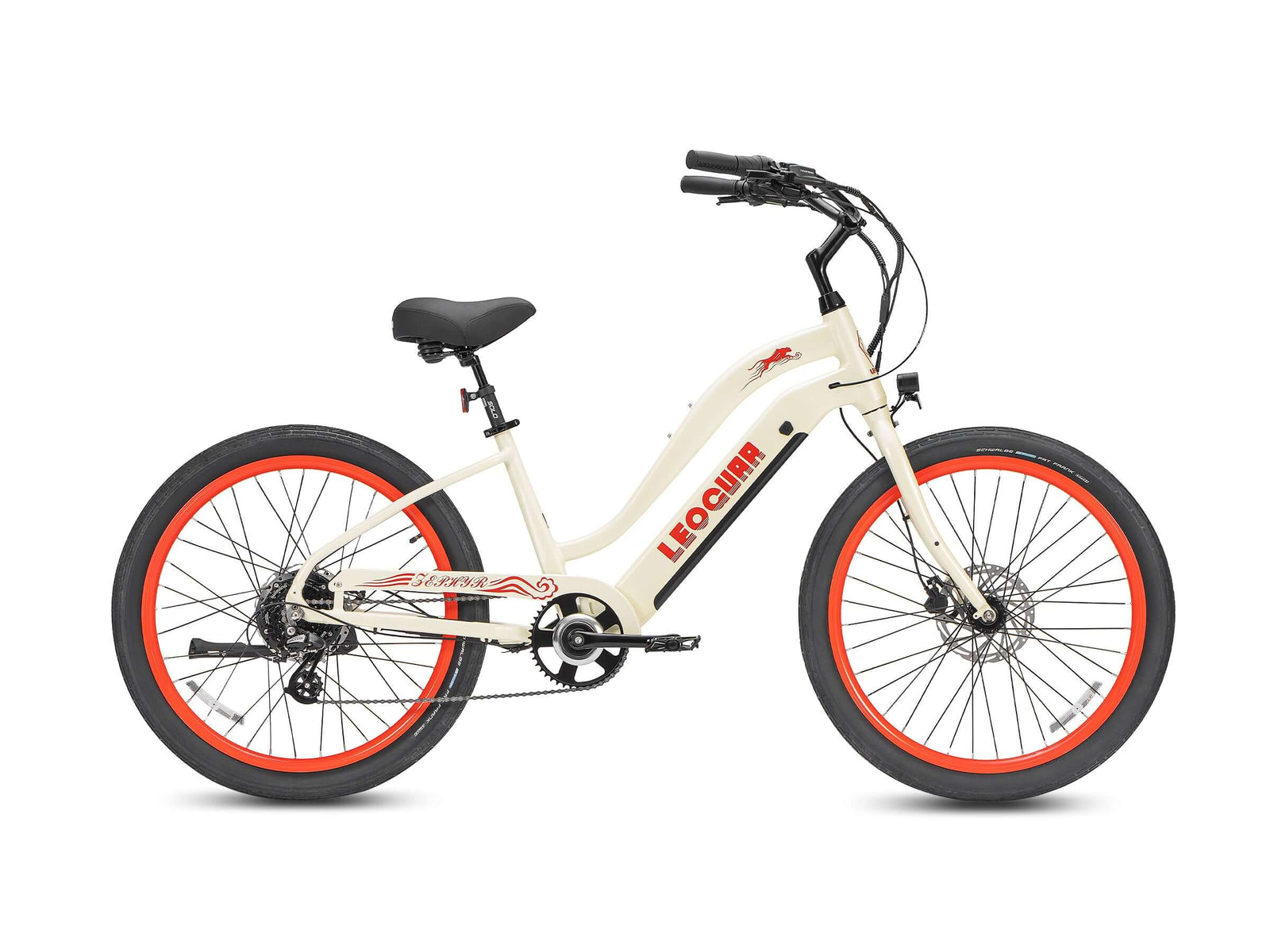








Leave a comment